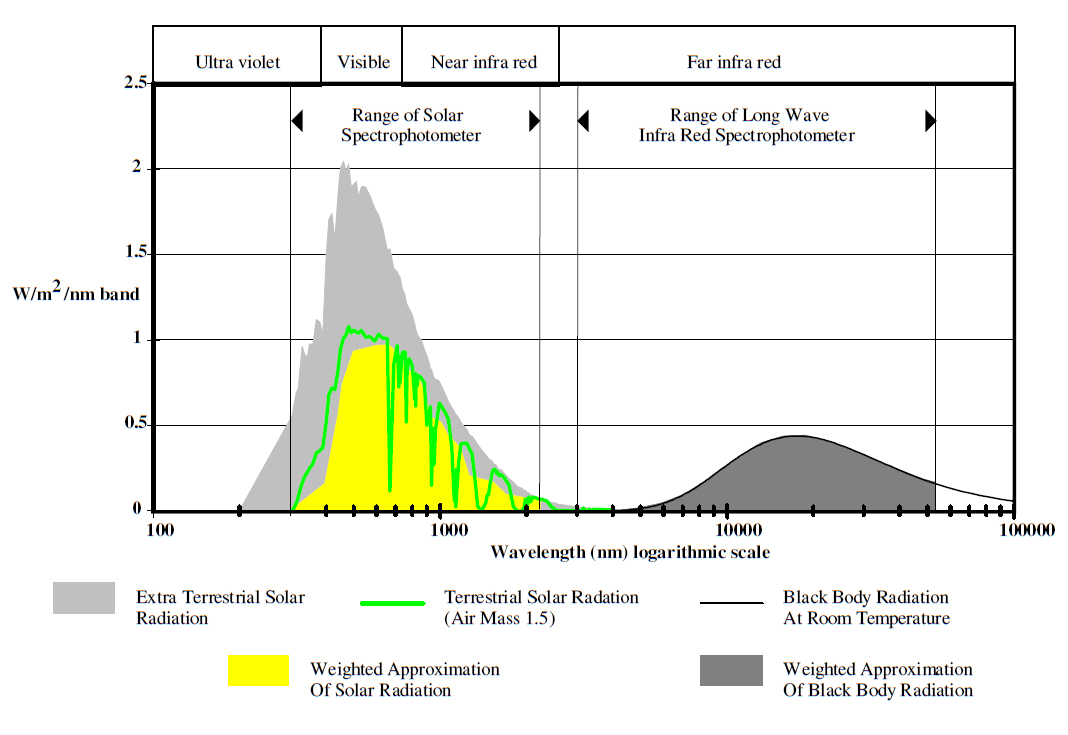Thermal optical properties
Contents |
[edit] Introduction
The thermal optical properties of a material describe its characteristic radiant behaviour within the thermal spectrum.
All bodies which are hotter than 0°K emit thermal radiation. They also absorb thermal radiation emitted by their surroundings. The difference in the total amount of radiation emitted and absorbed by a body at any given moment may result in a net heat transfer which will produce a change in the temperature of that body.
Thermal optical properties are treated as a function of three basic parameters; transmittance, reflectance, and absorptance, describing the ratio of the transmitted, radiated or absorbed radiant flux to the incident radiant flux. According to the Kirchoff relationship, within any specified waveband of the electromagnetic spectrum the sum of the absorptance, transmittance and reflectance of a material will equal one.
Radiation has direction. The directional quality of radiation is generally categorised as:
- Direct beam, which includes all collimated radiation, that is, 'rays' of radiation that are parallel.
- Diffuse, describing radiation propagated in many directions, i.e. it is not direct.
- Hemispherical, referring to the total hemispherical flux about the normal to a surface, i.e. the sum of diffuse and direct beam radiation.
As the directional nature of radiation incident upon a material changes, so the relative proportion which is absorbed, transmitted or reflected may vary significantly. This means that in order to properly quantify the optical properties of a material it is necessary to measure its transmittance, reflectance and absorptance as a function of angle of incidence.
Thermal radiation includes all those wavelengths of the electromagnetic spectrum which will heat a body when absorbed by it, ranging from about 100 nm to 100,000 nm. In general, the higher the temperature of a body, the lower the average wavelength of the radiation it emits. The range of terrestrial temperatures experienced within the built environment is comparatively small, and relative to the temperature of the sun this range is 'cold' and hence radiating at a longer wavelength. This anomaly allows us to categorise thermal radiation as short-wave solar radiation and terrestrial or long wave infra-red radiation.
The figure below shows the spectral distribution of this categorisation..
[edit] Solar optical properties
Solar radiation may be considered to include the ultra violet, visible and near or short wave infra-red wavebands. Around 97% of the solar radiation incident upon the earth's surface is within the range 300 to 2,300 nm. Its spectral profile is roughly analogous to that of a black body at 5,762°K, and as terrestrial temperatures are unlikely to reach anything like this temperature, solar radiation reaching the earth may be treated as a pure thermal gain.
The continually changing position of the earth relative to the sun, and the diffusing nature of the atmosphere gives solar radiation incident upon the earth's surface a complex directional composition. For simplicity however, this is usually considered to consist of entirely diffuse, and entirely direct beam components. If the direct beam solar optical properties of a material are known for all angles of incidence, then its diffuse properties may be calculated by integration.
[edit] Long wave infra-red optical properties
Most 'terrestrial' radiation occurs within the far or long wave infra-red wavebands. The wavelength of terrestrial radiation varies with temperature, however at room temperature approximately 97% of the radiation emanating from a perfect emitter will be within the range 3,000 nm to 50,000 nm.
Terrestrial surfaces emit long wave infra-red radiation in all directions within a hemisphere about their azimuth. This hemisphere can include a wide variety of thermal bodies, ranging from the clear night sky to relatively 'hot' solid bodies all of which will be emitting different intensities and wavelengths of thermal radiation themselves. In order to simplify this complex situation terrestrial radiation is generally treated as an average heat transfer based on hemispherical emissivities and average hemispherical surface temperatures.
According to Kirchoff's law the emissivity of a surface is equal to its radiant absorptivity at a given temperature and wavelength.
[edit] Related articles on Designing Buildings
- Albedo.
- Computational fluid dynamics (CFD).
- Electromagnetic energy.
- Electromagnetic spectrum.
- Emissivity.
- g-value.
- Gamma rays.
- Heat transfer.
- Light reflectance value.
- Low-e glass.
- Microwave.
- Overheating.
- Preventing overheating.
- Shading coefficient.
- Solar gain.
- Solar heat gain coefficient.
- Solar transmittance (gtot).
- The effects of electromagnetic fields in the workplace.
- Thermal bridge.
- Thermography for traditional buildings.
- U value.
- Visible light.
- X-rays.
Featured articles and news
Homes England creates largest housing-led site in the North
Successful, 34 hectare land acquisition with the residential allocation now completed.
Scottish apprenticeship training proposals
General support although better accountability and transparency is sought.
The history of building regulations
A story of belated action in response to crisis.
Moisture, fire safety and emerging trends in living walls
How wet is your wall?
Current policy explained and newly published consultation by the UK and Welsh Governments.
British architecture 1919–39. Book review.
Conservation of listed prefabs in Moseley.
Energy industry calls for urgent reform.
Heritage staff wellbeing at work survey.
A five minute introduction.
50th Golden anniversary ECA Edmundson apprentice award
Showcasing the very best electrotechnical and engineering services for half a century.
Welsh government consults on HRBs and reg changes
Seeking feedback on a new regulatory regime and a broad range of issues.
CIOB Client Guide (2nd edition) March 2025
Free download covering statutory dutyholder roles under the Building Safety Act and much more.
Minister quizzed, as responsibility transfers to MHCLG and BSR publishes new building control guidance.
UK environmental regulations reform 2025
Amid wider new approaches to ensure regulators and regulation support growth.
BSRIA Statutory Compliance Inspection Checklist
BG80/2025 now significantly updated to include requirements related to important changes in legislation.























